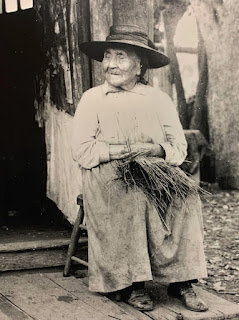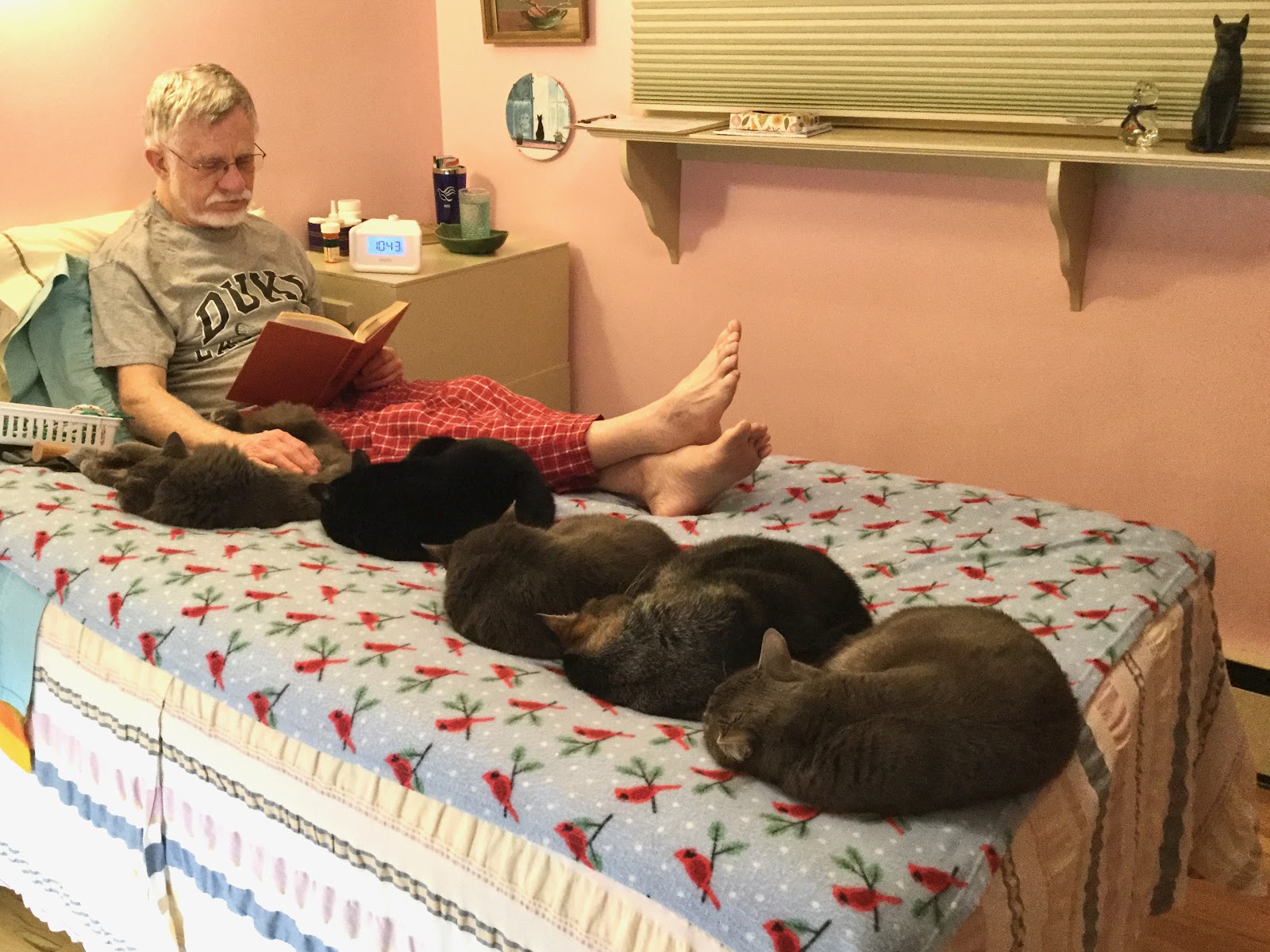 |
| Skinner’s Bird’s Nest |
Introduction
I wrote the following for a British blog buddy who wishes to honor me with a visit, but I then had the thought that it might interest others also...
Eugene, Oregon, was founded in 1846 by an Easterner named Eugene Skinner. Upon surveying the area’s enveloping ridgeline from the 682-foot hill in the foreground of the photo, he said “it looked like a bird’s nest.” Skinner had planned to name the town Marysville after his wife, but upon learning that the name was taken by another Oregon community (which later changed its name to Corvallis), his wife designated his new town Eugene City—which was shortened to Eugene in 1889. She also named the aforementioned hill after him, and it bears the name Skinner Butte. However, a highrise near the bottom of the butte bears the mountain’s Kalapuya Indian name, Ya Po Ah, which inexplicably means a very high place.
 | |||
| Mary Skinner |
On the west side of Skinner Butte are 45-foot basalt columns which Peggy used to climb in preparation for forays into the High Cascades. In recognition of her mountaineering achievements, the women of her climbing group ceremonially dubbed her Princess Climbing Rose.
 |
| Basalt Columns on Skinner Butte |
The distant hill in the top photo is five miles away at what is currently the southern edge of town. 2,058-foot Spencer
Butte bears the name of a young Englishman who was killed and mutilated by a Kalapuya Indian on the flank of what they called Rattlesnake Mountain. His
was the only known death at the hands of the Kalapuya while their tribe was destroyed by the violence and diseases of the white invaders. I will devote the remainder of this post to a description of the county of which Eugene is the county seat.
Origin: In 1851, Lane County was named after its first territorial governor, General Joseph Lane, an Indian killer and Mexican war hero. Although Lane soon lost favor in Oregon for his support of slavery and Southern secession, early Oregon was nonetheless racist. For example, in 1843, the Provisional Government of Oregon instituted the following punishment for black people who attempted to live here:
“…not less than twenty nor more than thirty-nine stripes, to be
inflicted by the constable of the proper county… if any free negro or
mulatto shall fail to quit the country within the term of six months
after receiving such stripes, he or she shall again receive the same
punishment once in every six months, until he or she shall quit the
country.”
Location: Lane County extends from the Pacific Ocean to the summit of the Cascade Mountains. Midway between the two is the Willamette Valley, a 120-mile long depression which begins near Eugene and ends near Portland. Although the valley is tiny compared to Oregon’s total land area, three out of four Oregonians live here. Willamette (pronounced wil LAM ette) is a Kalapuya Indian word for Valley of Sickness, a name that was inspired by its supposed healing qualities.
Size: Although Lane County is sixth in size among Oregon counties, it is four times larger than Rhode Island, twice the size of Delaware, and nearly as big as Connecticut. Oregon itself is the tenth largest of American states.
Parks: 12-mile long, 2,000 acre Ridgeline Park is Eugene’s largest followed by 240 acre Spencer Butte Park and 100 acre Skinner Butte Park. Added together, this town of 175,000 people has an impressive 4,200 acres of parkland, while over half of Lane County itself is owned by federal, state, county, and city governments.
Precipitation: Eugene gets 41-inches of rain per year, and isolated parts of the Coast Range get over 100-inches. Precipitation in the Cascade Range consists largely of snow. Due to global warming, the amount of snow in the mountains has dropped dramatically since my arrival in 1986. This is worrisome because the Valley depends upon melting snow to fill its reservoirs.
Deepest Lake: 420-foot, glacier-carved Waldo Lake.
Largest Rivers: the Willamette, the McKenzie, and the Siuslaw. Until the coming of the railroad, steamboats traversed the 300 Willamette River miles from Portland to Eugene—the straight-line distance is a hundred miles.
Elevation: From sea level at the coast to 10,358-feet in the Cascades.
Number of Mountains: 703
Mountain Ranges: Lane County contains portions of the Cascades and the Calapooyas, both of which are volcanic. The Cascades can be further divided into the High Cascades and the Old Cascades—the Calapooyas are a segment of the latter. Lane County also contains a portion of the thousand-mile long Coast Range, which was formed by uplift when the Pacific Plate slid under the North American Plate. 4,097-ft. Mary’s Peak is its highest point in Oregon.
Number of Active Volcanoes: Seismologists are monitoring a slowly growing bulge on the west side of Lane County’s only active volcano, the South Sister.
Greatest Natural Hazard: The Cascadia Subduction Zone is a 700-mile long area where the aforementioned tectonic plates are colliding. There is a 37% risk of a +9.0 earthquake erupting along this fault in the next fifty years. Before moving here, I had lived with hurricanes, thunderstorms, and tornadoes for my entire life, and there is no way that I would have moved to a place at risk of a megaquake had I known of it, but the threat was not known at the time.
Number of Waterfalls: 206 (https://www.waterfallsnorthwest.com/Oregon/County/Lane)
Number of Glaciers: 7 remain but are rapidly melting.
Tallest Waterfall: 286-foot Salt Creek Falls
Number of Hot Springs: 4
Tallest Tree: a 310-foot Douglas Fir. The Douglas Fir is Oregon’s “State Tree” and its primary timber source.
Number of Covered Bridges: 20.
Ten Crops: 90% of Lane County is forestland, but mint, hops, berries, hazelnuts, lavender, rosemary, vegetables, tree fruits, wine grapes, and Christmas trees, number among its other delightful crops.
Ten Fun Things to Do: hike, bike, ski, raft, fish, kayak, skateboard, snow ski, mountain climb, fly kites at the coast.
Population by Race: People of northern European ancestry constitute 89% of the population followed by Hispanics, Asians, indigenous, and black.(3) Despite the area’s racial homogeneity, modern Lane Countians
Lane County’s Indigenous Peoples: The last full-blood Kalapuya was “Aunt” Eliza Young who died in 1922, seventy-five years after her relatives offered the hand of friendship to Eugene Skinner. A large majority of Oregon’s Indians died of European diseases that were introduced by an ever increasing number of arrivals starting with the Spanish gold seeker Juan Cabrillo in 1542. Of those Indians who survived smallpox, typhus, typhoid, cholera, measles, pertussis, and other diseases, some were murdered (there being no penalty for it), but most died of neglect after being imprisoned on barren reservations. Even that wasn’t enough for immigrants who believed that America was a modern day Israel; that white Americans had replaced Jews as God’s chosen people; and that indigenous Americans were the equivalent of the Biblical idol worshipers that God ordered killed. By the printing of the March 16, 1872, edition of the Eugene Guardian, few Kalapuya remained, yet this didn’t deter the editor from labeling them a “disgrace” and demanding that they be “tarred, feathered, and hung.”
| The Pioneer Mother |
Politics: The pendulum has swung to the opposite side of the stupid spectrum since the days when Chinese railroad builders were called chinks and cooleys and the Ku Klux Klan burned crosses on Skinner Butte in order to intimidate Jews, liberals, non-whites, suffragists, and Catholics. Some examples.... In 2020, Eugene businesses and vehicles were vandalized when a black man 2,000 miles away was killed by a policeman. In another incident, a monument honoring Lane Countians who died in World War II was vandalized, and in a third, University of Oregon students pulled down two large statues
and battered one of them with sledgehammers after hearing their history professor say that the Oregon Trail pioneers were thieves, rapists, and murderers who thought they were serving God by destroying lives and cultures that they deemed worthless. Although the demonstration was filmed by scores of cameras, no arrests were made, and the university declined to restore the statues.
Religion: 75% of Lane Countians have no religion followed by the 13% who are Protestant and the 6% who are Catholic. My previous county in Mississippi is at the other end of the American spectrum with 79% of its residents saying they are religious and 0% daring to say that they are not. Religious oppression served as a major motivator for me leaving the state. In one memorable incident, I was rapped on the head by another juror when I declined to stand for a prayer that was led by the district attorney.
Noteworthy Movies: My first glimpse of Lane County came from the movie Animal House with John Belushi (1978), but Stand By Me with River Phoenix (1986) and The General with Buster Keaton (1926) are far better movies that offer a far better look at the countryside. For a list of movies that were shot entirely in Eugene, go to Wikipedia, Films Shot in Eugene.
Nicknames for Eugene: Emerald City, Track Town USA, and Track and Field Capital of the World. The name Emerald City was inspired by the greenery, the others by Eugene’s prominence in track and field events, among which are try-outs for the Olympics. Appropriately, University of Oregon track coach Bill Bowerman invented the first spikeless track shoe (his company became Nike) in Eugene. Without Limits is a Eugene-made movie about Bowerman and his best-known runner, Steve Prefontaine, who died in a car accident in Eugene at age 24.
 |
| Memorial at Site of Accident |
Ten Delightful Crops: grapes, mint, hops, berries, hazelnuts, lavender, rosemary, vegetables, tree fruit, Christmas trees.
Ten Popular Things to Do: hike, bike, ski, raft, run, fish, kayak, skateboard, snow ski, mountain climb.
Ten Things that Oregon Got Right: The city of Eugene has purchased over twelve miles of encircling ridgeline so its residents can see trees rather than highrises when they lift their eyes to the hills. Every inch of Oregon’s 362-mile coastline is publicly owned and publicly accessible, and Oregon led the nation in passing a bottle bill, legalizing assisted suicide, decriminalizing cannabis, voting entirely by mail, electing a LGBT governor, legalizing psilocybin, automatic voter registration, and mandating an end to coal-fired power.
A Virtually Unkown Event in Oregon’s History:
The following isn’t related to Lane County, but I’m going to close with it because it is so interesting and so undeservedly forgotten, even in Oregon. On May 5, 1945, Oregon suffered the American mainland’s only World War II fatalities when a woman and five children were killed by a Japanese balloon bomb while picnicking. Some of the women who manufactured the 9,300 balloon bombs that were launched by Japan later apologized for those deaths. The attack had been in retaliation for the 300,000 Japenese deaths in American firebombings of the Japanese mainland. Other nearby Japanese attacks consisted of a submarine firing upon an Oregon fort, and a submarine-carried float-plane dropping incendiaries on an un-inhabited mountain in the hope of starting a forest fire.
In closing: “Renew your youth, enjoy life, and start for heaven from the best town on earth, Eugene, Oregon.” Anybody’s Magazine 1906







